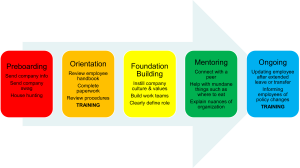8-2: Types of Training
 Now that we understand why training matters and how to figure out what’s needed, let’s explore the different types of training you’re likely to encounter in your career. Organizations employ diverse training approaches to address different learning objectives and organizational requirements. Think of this as your training menu – different situations call for different approaches.
Now that we understand why training matters and how to figure out what’s needed, let’s explore the different types of training you’re likely to encounter in your career. Organizations employ diverse training approaches to address different learning objectives and organizational requirements. Think of this as your training menu – different situations call for different approaches.
Orientation and Onboarding Training
Remember your first day at a new job? The mix of excitement and overwhelm is pretty universal. Orientation and onboarding training serves to integrate new employees into the organization and prepare them for their specific role responsibilities.
Orientation typically provides a brief introduction to the company, covering basic information about organizational history, policies, procedures, and culture. It’s like getting the lay of the land. Onboarding training extends beyond orientation to help new hires become invested in their duties and develop the knowledge and skills needed for early job success.

Here’s a pro tip: effective onboarding focuses on information and tools needed during the first few weeks of employment rather than comprehensive coverage of all organizational policies and procedures. Organizations should avoid information overload while ensuring that critical knowledge is conveyed promptly. Nobody wants to drink from a fire hose on their first day!
Creating accessible repositories of information, such as wikis or online resource centers, enables new employees to access additional information as needed. Organizational socialization represents the broader process by which employees acquire the attitudes, behaviors, and knowledge needed to participate as organizational members.
Compliance Training
Let’s talk about the training nobody gets excited about but everyone needs: compliance training. This encompasses any training that all employees must undergo to meet legal, regulatory, or organizational requirements. Occupational Safety and Health Administration (OSHA) guidelines often mandate specific training content for legal compliance.
Organizations unsure about compliance training requirements should consult with employees about their biggest challenges and information needs, as repeatedly mentioned issues likely represent compliance training material. According to research, compliance training reduces the risk of legal and ethical violations by ensuring employees are well-informed about laws and company policies. Interactive and engaging compliance training fosters a culture of accountability and respect, building trust both internally and with customers.
Technical Training
Technical training develops job-specific skills and knowledge required for effective performance in particular positions. This training typically focuses on equipment operation, software applications, procedures, or other technical competencies directly related to job tasks. Think of learning new software, operating machinery, or mastering industry-specific tools.
Technical training often requires hands-on practice and may benefit from simulation or work sample approaches that closely mirror actual job conditions. After all, you can’t really learn to drive by just reading about it!
Safety Training
Safety training addresses hazard recognition, accident prevention, emergency procedures, and other safety-related competencies essential for maintaining safe work environments. This becomes particularly critical in high-risk industries where inadequate training can result in serious injuries, fatalities, or environmental damage.
Effective safety training often combines knowledge acquisition with behavioral practice and must be regularly updated to address changing workplace conditions. It’s not just about following rules – it’s about developing the instincts and habits that keep everyone safe.
Ethics Training
In our complex business world, ethics training develops understanding of ethical principles, organizational values, and appropriate decision-making processes for handling ethical dilemmas. Ethics training becomes increasingly important as organizations face complex stakeholder demands and regulatory requirements.
Effective ethics training goes beyond rule-based approaches to develop ethical reasoning capabilities that can be applied to novel situations. It’s about helping you navigate those gray areas where the right answer isn’t always obvious.
Leadership Training
Here’s where things get interesting. Leadership training focuses on soft skills that enhance interpersonal effectiveness with particular emphasis on leadership qualities and abilities. Poor leadership creates negative experiences for employees and can significantly impact organizational performance.
Leadership training typically addresses communication, delegation, coaching, conflict resolution, and strategic thinking capabilities. Burke and Day (1986) conducted a comprehensive meta-analysis demonstrating that managerial training programs produce positive outcomes across various criteria, with leadership training showing particularly strong effects on subjective behavioral measures.
Assertiveness Training
Assertiveness training teaches individuals to act in bold, self-confident manners when situations require clear communication or decisive action. This training proves particularly valuable in contexts where hesitancy or poor communication can create safety hazards.
Here’s a sobering example: pilots receive assertiveness training because air accidents have sometimes resulted from copilots’ unwillingness to challenge pilots’ decisions or express safety concerns. The 1982 Air Florida crash in Washington, DC, exemplifies this problem, as the copilot’s reluctance to disagree with the pilot about deicing procedures contributed to an accident that killed 78 people. Sometimes speaking up isn’t just important – it’s literally a matter of life and death.
Sexual Harassment Training
Sexual harassment training addresses the prevention and appropriate response to sexual harassment in workplace settings. Sexual harassment creates three dimensions of negative consequences: widespread implications for work outcomes including relationships and career direction; psychological and somatic outcomes such as reduced self-esteem and increased health problems; and organizational consequences including turnover and absenteeism.
Training can prevent unwanted behaviors through education about appropriate conduct and organizational policies. Common approaches use video modeling to demonstrate acceptable and unacceptable behaviors. Research indicates that behavior modeling sensitizes individuals to sexual harassment behaviors, though males and females may view identical behaviors differently regarding their potential for harassment.
Diversity Training
Diversity training teaches employees to work respectfully and effectively with people from various backgrounds. Anti-bias and diversity training typically pursues three primary objectives: increasing awareness about diversity issues; reducing bias and stereotyping that interfere with effective management; and changing behaviors to more effectively manage diverse workforces.
Traditional diversity training often uses scenarios to illustrate how certain phrases can be offensive to people from different backgrounds and demonstrates how situations could be handled more appropriately. Interactive quizzes help ensure learning and engagement with training content.
Bezrukova, Spell, Perry, and Jehn (2016) found through comprehensive meta-analysis that diversity training programs are more effective when they are part of broader organizational diversity initiatives and receive strong organizational support.
Alternative approaches to diversity training focus on creating “cultures of diversity” characterized by relational environments where people feel proud of their uniqueness while being socially integrated. These approaches require organizational strategies that take advantage of multiple perspectives rather than merely tolerating differences.
Understanding Microaggressions
Microaggressions represent subtle everyday comments or interactions that communicate bias based on stereotypes about appearance, identity group membership, or other assumed differences. While microaggressions can be intentional, they more often occur unintentionally. These behaviors can make people feel alienated, cause physiological and psychological stress, limit opportunities, and contribute to mental health issues including depression and trauma.
Six Major Impacts of Exclusion
Diversity training increasingly addresses six major impacts of exclusion: stereotype threat, imposter syndrome, post-traumatic stress, disengagement, attrition, and poor organizational reputation that affects recruitment efforts. Understanding these impacts helps organizations recognize the business case for diversity and inclusion beyond legal compliance requirements.
Media Attributions
- Management Training © Digits.co.uk Images is licensed under a CC BY (Attribution) license
- Onboarding © Jay Brown
